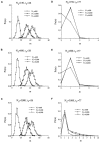A population-genetic test of founder effects and implications for Ashkenazi Jewish diseases
- PMID: 15208782
- PMCID: PMC1216062
- DOI: 10.1086/423146
A population-genetic test of founder effects and implications for Ashkenazi Jewish diseases
Abstract
A founder effect can account for the presence of an allele at an unusually high frequency in an isolated population if the allele is selectively neutral and if all copies are identical by descent with a copy that either was carried by a founder individual or arose by mutation later. Here, a statistical test of both aspects of the founder-effect hypothesis is developed. The test is performed by a modified version of a program that implements the Slatkin-Bertorelle test of neutrality. The test is applied to several disease-associated alleles found predominantly in Ashkenazi Jews. Despite considerable uncertainty about the demographic history of Ashkenazi Jews and their ancestors, available genetic data are consistent with a founder effect resulting from a severe bottleneck in population size between a.d. 1100 and a.d. 1400 and an earlier bottleneck in a.d. 75, at the beginning of the Jewish Diaspora. The relatively high frequency of alleles causing four different lysosomal storage disorders, including Tay-Sachs disease and Gaucher disease, can be accounted for if the disease-associated alleles are recessive in their effects on reproductive fitness.
Figures




References
Electronic-Database Information
-
- Online Mendelian Inheritance in Man (OMIM), http://www.ncbi.nlm.nih.gov/Omim/ (for type I Gaucher disease, MLIV, and APC)
-
- Slatkin Laboratory Genetics Software, http://ib.berkeley.edu/labs/slatkin/software.html
-
- TSC SNP Linkage Map, http://compgen.rutgers.edu/SNPmap/
-
- UCSC Human Genome Browser, http://genome.ucsc.edu/cgi-bin/hgGateway
References
-
- Barnavi E (ed) (1992) A historical atlas of the Jewish people: from the time of the Patriarchs to the present. Knopf, New York
-
- Blumenfeld A, Slaugenhaupt SA, Liebert CB, Temper V, Maayan C, Gill S, Lucente DE, Idelson M, MacCormack K, Monahan MA, Mull J, Leyne M, Mendillo M, Schiripo T, Mishori E, Breakefield X, Axelrod FB, Gusella JF (1999) Precise genetic mapping and haplotype analysis of the familial dysautonomia gene on human chromosome 9q31. Am J Hum Genet 64:1110–1118 - PMC - PubMed
Publication types
MeSH terms
Grants and funding
LinkOut - more resources
Full Text Sources
Medical
Molecular Biology Databases

